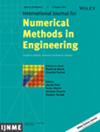摘要
本文在局部梯度损伤理论框架下建立了准脆性材料热致裂纹的热-力耦合模型。为了保证热力学一致性,基于Clausius-Duhem不等式建立了考虑热膨胀效应的本构关系和考虑体积应变和损伤演化的热传导方程。特别地,为了适应不同准脆性材料的拉压强度不对称,提出了一种改进的Mazars应变作为微等效应变的驱动力,其中引入了应变张量的第一不变量和可调的抗压强度与抗拉强度之比(k $$ k $$)。数值实现采用广义-α法进行时域离散,采用交错格式进行解耦。数值模拟表明,改进的Mazars应变在捕获拉伸和混合模式破坏方面具有良好的可行性,并且所提出的模型能够在准静态和动态两种情况下表征热载荷下的复杂裂纹行为。陶瓷板的淬火试验模拟突出了裂纹模式的双向耦合效应。忽略体积应变和损伤演化对温度场影响的单向耦合模型会低估温度梯度,导致裂纹间距增大,裂纹数量减少。在圆柱形试样的热冲击试验中,裂纹模式随着压拉强度比(k $$ k $$)的增加而从螺旋剪切带向环形损伤区转变的过程被精确捕获,证明了所提出的模型对于各种具有拉压强度不对称的准脆性材料的普遍性。This work establishes a thermo-mechanical coupling model for thermally induced cracks in quasi-brittle materials within the framework of localizing gradient damage theory. The constitutive relation considering the thermal expansion effect, and the heat conduction equation integrating the volumetric strain and damage evolution, are formulated based on the Clausius–Duhem inequality to ensure thermodynamic consistency. In particular, to accommodate the tension-compression strength asymmetry across different quasi-brittle materials, a modified Mazars strain is proposed as the driving force for the micro equivalent strain, where the first invariant of strain tensor and an adjustable ratio of compressive strength to tensile strength () are introduced. The numerical implementation employs the generalized-α method for time domain discretization and the staggered scheme for decoupling. Numerical simulations demonstrate a nice feasibility of the modified Mazars strain in capturing both tensile and mixed-mode failures, and the proposed model proves capable of characterizing complex crack behaviors under thermal loading in both quasi-static and dynamic scenarios. The quenching test simulations of ceramic plates highlight the bidirectional coupling effects on crack patterns. Unidirectional coupling models that ignore the influence of volumetric strain and damage evolution on the temperature field would underestimate the temperature gradient, resulting in larger crack spacing and fewer cracks. In the thermal shock tests of cylindrical specimens, the transition in crack patterns from spiral shear bands to an annular damage zone with increasing compression-tension strength ratio () is precisely captured, demonstrating the generality of the proposed model for various quasi-brittle materials with tension-compression strength asymmetry.

 求助内容:
求助内容: 应助结果提醒方式:
应助结果提醒方式:


